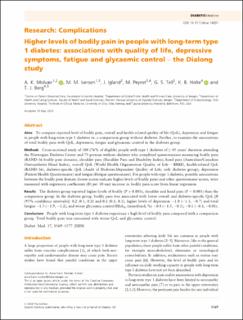| dc.description.abstract | Aims
To compare reported level of bodily pain, overall and health‐related quality of life (QoL), depression and fatigue in people with long‐term type 1 diabetes vs. a comparison group without diabetes. Further, to examine the associations of total bodily pain with QoL, depression, fatigue and glycaemic control in the diabetes group.
Methods
Cross‐sectional study of 104 (76% of eligible) people with type 1 diabetes of ≥ 45 years’ duration attending the Norwegian Diabetes Centre and 75 persons without diabetes who completed questionnaires measuring bodily pain (RAND‐36 bodily pain domain), shoulder pain (Shoulder Pain and Disability Index), hand pain (Australian/Canadian Osteoarthritis Hand Index), overall QoL (World Health Organization Quality of Life – BREF), health‐related QoL (RAND‐36), diabetes‐specific QoL (Audit of Diabetes‐Dependent Quality of Life; only diabetes group), depression (Patient Health Questionnaire) and fatigue (Fatigue questionnaire). For people with type 1 diabetes, possible associations between the bodily pain domain (lower scores indicate higher levels of bodily pain) and other questionnaire scores, were measured with regression coefficients (B) per 10‐unit increase in bodily pain score from linear regression.
Results
The diabetes group reported higher levels of bodily (P = 0.003), shoulder and hand pain (P < 0.001) than the comparison group. In the diabetes group, bodily pain was associated with lower overall and diabetes‐specific QoL [B (95% confidence intervals)]: 0.2 (0.1, 0.2) and 0.2 (0.1, 0.3); higher levels of depression −1.0 (−1.3, −0.7) and total fatigue −1.5 (−1.9, −1.2); and worse glycaemic control HbA1c (mmol/mol; %) −0.8 (−1.5, −0.1); −0.1 (−0.1, −0.01).
Conclusions
People with long‐term type 1 diabetes experience a high level of bodily pain compared with a comparison group. Total bodily pain was associated with worse QoL and glycaemic control. | en_US |

